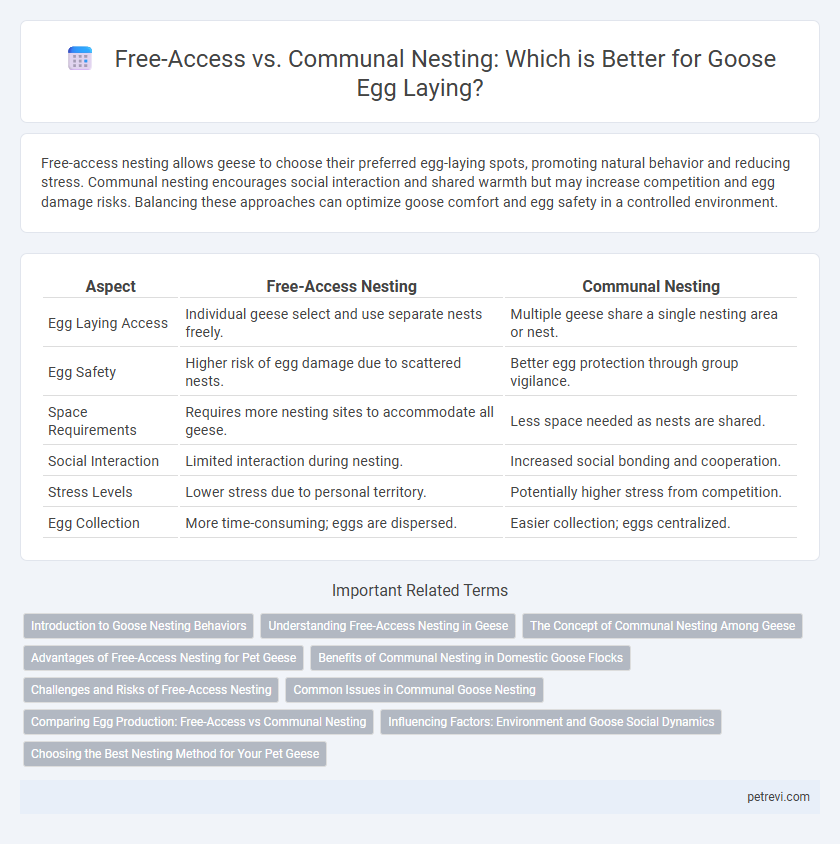Free-access nesting allows geese to choose their preferred egg-laying spots, promoting natural behavior and reducing stress. Communal nesting encourages social interaction and shared warmth but may increase competition and egg damage risks. Balancing these approaches can optimize goose comfort and egg safety in a controlled environment.
Table of Comparison
| Aspect | Free-Access Nesting | Communal Nesting |
|---|---|---|
| Egg Laying Access | Individual geese select and use separate nests freely. | Multiple geese share a single nesting area or nest. |
| Egg Safety | Higher risk of egg damage due to scattered nests. | Better egg protection through group vigilance. |
| Space Requirements | Requires more nesting sites to accommodate all geese. | Less space needed as nests are shared. |
| Social Interaction | Limited interaction during nesting. | Increased social bonding and cooperation. |
| Stress Levels | Lower stress due to personal territory. | Potentially higher stress from competition. |
| Egg Collection | More time-consuming; eggs are dispersed. | Easier collection; eggs centralized. |
Introduction to Goose Nesting Behaviors
Goose nesting behaviors vary between free-access nesting, where individual geese select isolated sites to lay eggs, and communal nesting, which involves groups sharing a single nest to enhance protection and warmth. Free-access nesting allows for reduced competition but can increase vulnerability to predators, while communal nesting optimizes incubation efficiency and collective defense. Understanding these strategies is vital for managing goose populations and conserving their habitats effectively.
Understanding Free-Access Nesting in Geese
Free-access nesting allows geese to lay eggs without confinement, promoting natural behaviors and reducing stress levels. This method supports higher egg fertility and better hatch rates due to increased comfort and less disturbance. Understanding free-access nesting highlights its benefits over communal nesting, such as enhanced individual space and decreased aggression among geese.
The Concept of Communal Nesting Among Geese
Communal nesting among geese involves multiple females laying eggs in a single shared nest, enhancing protection against predators through collective vigilance. This behavior optimizes resource use and increases the survival rate of goslings by pooling parental care and warmth. Studies show that communal nests often contain higher egg counts and benefit from synchronized hatching, improving offspring survival compared to solitary free-access nesting.
Advantages of Free-Access Nesting for Pet Geese
Free-access nesting allows pet geese to choose their preferred laying sites, reducing stress and promoting natural behaviors which can improve egg quality and hatching success. This method encourages individual territory establishment, minimizing conflicts and damage to eggs common in communal nesting environments. Enhanced comfort and autonomy in free-access nesting contribute to overall better health and productivity in pet geese.
Benefits of Communal Nesting in Domestic Goose Flocks
Communal nesting in domestic goose flocks enhances egg protection by pooling vigilance among multiple birds, reducing predation risks to eggs. It promotes more efficient use of nesting space, conserving energy and resources for the flock. Social bonding and synchronized hatching in communal nests strengthen flock cohesion and improve gosling survival rates.
Challenges and Risks of Free-Access Nesting
Free-access nesting for goose egg laying often leads to increased risks of egg predation and nest disturbance due to lack of protection and monitoring. This method exposes eggs to environmental hazards and potential trampling by other geese, resulting in lower hatching success rates. The absence of controlled nesting sites also complicates management efforts to ensure optimal incubation conditions and reduce egg loss.
Common Issues in Communal Goose Nesting
Communal nesting among geese often leads to egg breakage due to overcrowding and competition for prime nesting spots, resulting in lower hatching success rates compared to free-access nesting. Increased aggression and egg theft are common in communal settings, which can stress the geese and reduce overall reproductive output. Proper management strategies, including adequate nesting space and monitoring, are essential to mitigate these issues and improve gosling survival.
Comparing Egg Production: Free-Access vs Communal Nesting
Goose egg production varies significantly between free-access and communal nesting systems, with free-access nesting generally yielding higher egg numbers due to reduced stress and increased laying comfort. Free-access nests allow individual geese to select private sites, enhancing fertility rates and minimizing egg damage compared to communal nests where competition and overcrowding often reduce overall productivity. Studies indicate that providing free-access nesting options can boost egg output by up to 20% compared to communal nesting setups, optimizing hatchability and flock reproduction efficiency.
Influencing Factors: Environment and Goose Social Dynamics
Environmental factors such as temperature, predator presence, and habitat stability significantly influence goose egg-laying behavior, with free-access nesting preferred in stable, low-threat environments. Goose social dynamics, including dominance hierarchies and pair bonding, drive communal nesting to enhance protection and increase reproductive success. Balancing these influences, geese optimize egg survival by selecting nesting strategies suited to both ecological conditions and social structures.
Choosing the Best Nesting Method for Your Pet Geese
Free-access nesting allows pet geese to select individual nesting sites freely, promoting natural behaviors and reducing stress during egg laying. Communal nesting, while space-efficient, may increase competition and aggression, potentially leading to egg damage or lower hatch rates. Choosing the best nesting method depends on flock size, available space, and monitoring capabilities to ensure optimal egg protection and goose welfare.
Free-access nesting vs Communal nesting for Goose Egg Laying Infographic

 petrevi.com
petrevi.com